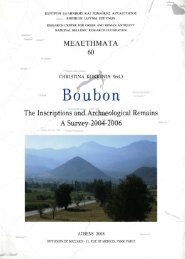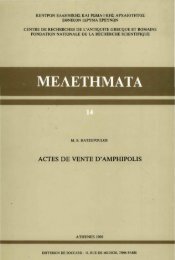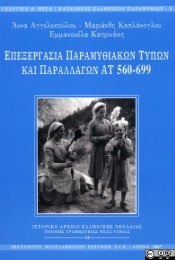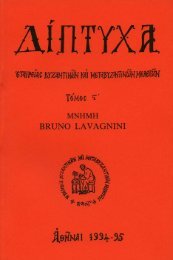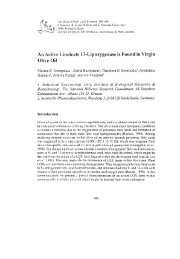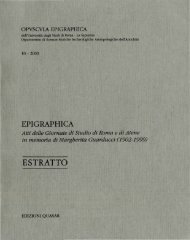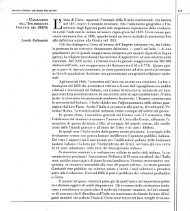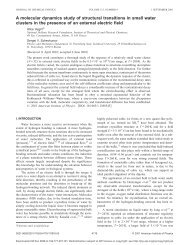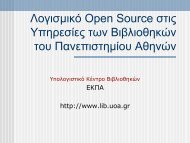roman name-formula
roman name-formula
roman name-formula
- No tags were found...
You also want an ePaper? Increase the reach of your titles
YUMPU automatically turns print PDFs into web optimized ePapers that Google loves.
Mócsy's hypothesis that the diplomata consistently<br />
repeat the <strong>name</strong>-<strong>formula</strong>e under which the recipients<br />
were originally entered in the lists of recruits<br />
preservedin the officiaoïthe provinces' governors.<br />
It is still less compatible with the corollary of the<br />
same hypothesis which makes the lists subject to<br />
their compilers ' arbitrary choice between the PNF<br />
and the CNF, and ascribes the clerks a tendency<br />
not only to give the CNF to the peregrine tirones<br />
but also to change the tirones' native <strong>name</strong>s<br />
(cognomina) into "einfache lateinische Namen...<br />
die aus einer beschränkten Zahl von 'Soldaten<strong>name</strong>n'<br />
gewählt wurden" 27 .<br />
The Syrian examples —pertaining to a major<br />
province, which has left us a comparatively<br />
important amount of documentation— suffice to<br />
show some defects of the theory that provincial<br />
recruiting-officers had their own standards as to<br />
the selection of the recruits' <strong>name</strong>-<strong>formula</strong>e,<br />
standards allegedly determining the way in which<br />
the "personal" part of the auxiliary diploma text<br />
was going to be <strong>formula</strong>ted more than two and a<br />
half decades after the probatio. Our catalogue cites<br />
five men from that province, who were granted<br />
their diplomata in AD 98, 120, 122, 138, and<br />
178/190 respectively. Their CNF has been expressed<br />
through at least three variants (c, d, e, possibly<br />
also a) 28 . Besides, Syria has produced a PNF<br />
recipient (RMD2, of AD 75 : Herae Serapionis f.,<br />
Antioc), who must have been a peregrine to judge<br />
(i.a.) from the early date of the document. To that<br />
plurality of <strong>name</strong>-<strong>formula</strong>e belonging to auxiliaries<br />
whose origins were in the same province, another<br />
detail can be added which also contradicts Mócsy 's<br />
ingenious conjectures: both the patronymic and<br />
the <strong>name</strong> (cognomen) of the Antiochene of RMD<br />
2 are non-Roman —nothing similar to the simple<br />
"Soldaten<strong>name</strong>n",— and the same holds true for<br />
the soldier rewarded in AD 120. Finally, the origines<br />
as quoted supra show a variety of form and content<br />
which by itself contrasts with the practice of distinct<br />
provincial patterns assumed by Mócsy. Thus we<br />
see the dative Syro in AD 122, the toponyms in<br />
the ablatives in AD 98,120 (probably) 29 , and 138,<br />
and the composite <strong>formula</strong> [— ] a ex Syr(ia) in<br />
178/190. Diplomata whose recipients did not<br />
belong to the group of auxiliaries with the CNF<br />
make this repertory somewhat more complete:<br />
36<br />
S. DUSANIC<br />
Suros ( ! ) (XVI8, AD 68), Suro Garaseno ( ! ) (XVI<br />
15, AD 71), and Antiochia ex Syria Coele (ZPE<br />
96 [ 1993] 77; AD 206). All these variations of the<br />
<strong>formula</strong>e noting the recipients' home —their<br />
orthography as well as their structure— can also<br />
be followed in diplomata distributed to men from<br />
other provinces, even Italy itself. They illustrate<br />
changes and oscillations in the scribal conventions<br />
in central officia, not the decisive influence of lists<br />
composed locally, in Syria or elsewhere.<br />
(ID<br />
Our short catalogue gives us an insight into the<br />
family situations of the auxiliary aere incisi born<br />
in "Oriental" provinces. There are reasons to believe<br />
that the most of them were families of Roman<br />
citizens.<br />
To begin with, in at least four diplomata (of AD<br />
93, 122,134, and 179), the recipient's filiation is<br />
that by (his father's) gentile. The case of M. Antonius<br />
Maximus' wife is probably the same (AD<br />
122) 30 . Though the purpose of the <strong>formula</strong>—which<br />
is not rare in inscriptions and other diplomata—<br />
has been a matter of learned controversy, it is<br />
difficult to escape from the conclusion that "it was<br />
to give sure proof of Roman citizenship" as "the<br />
normal method (i.e. the filiation by praenomen)<br />
could be usurped by peregrines" 3 '. Neither<br />
27. RMDHQ462 (Mócsy).<br />
28. (C): AD 98; (d): AD 120; (e): AD 122; (d) or, less<br />
probably, (e): AD 138 (the [—]e f. ended a cognomen —<br />
e.g. [Galba]ef.—ratherthan agentile—e.g. [Caecina]ef.;<br />
(e), (d) or, less probably, (a): AD 178/190 (the [- - -]i f. should<br />
de restored as a gentile or a cognomen rather than a<br />
praenomen).<br />
29. The alternative HeliopoI(itano)stems less plausible,<br />
cf. Nicopoli (RMD 132), Claudiopoli(RMD 133).<br />
30. It seems that her gentile was Messia, not Valeria<br />
(which should be taken for the gentile in the function of the<br />
cognomen). The position of the two <strong>name</strong>s has been changed<br />
by an inversion well known from epigraphical documents.<br />
31. Holder (supra, note 17) 51. Aliter, F. Papazoglou<br />
(infra, note 61 ) 317 note 55 (on the Ulpius Ulpi f. of RMD<br />
123).



